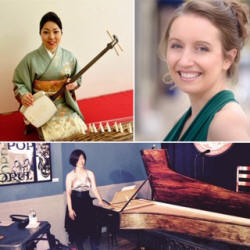 Long before Xena Warrior Princess, La Femme Nikita and Diana Prince, there
were the Wonder Women of the baroque period. Back then, female composers
were a bit thin on the ground, but there were some who could hold their own in a
world with rigid gender roles. We caught up with Ensemble Leonarda’s
harpsichordist, Nancy Kito.
Long before Xena Warrior Princess, La Femme Nikita and Diana Prince, there
were the Wonder Women of the baroque period. Back then, female composers
were a bit thin on the ground, but there were some who could hold their own in a
world with rigid gender roles. We caught up with Ensemble Leonarda’s
harpsichordist, Nancy Kito.
Casey Ann Reinke: Why the title “Wonder Women”?
Nancy Kito: (laughs) It came about in a “Six Degrees of Kevin Bacon” way. The year 2020 is the 400th anniversary of our namesake, Isabella Leonarda, who was an Italian Ursuline nun (born 1620). Daughter of the nobility, her published music fills 20 volumes. We thought to do a program celebrating the music of Leonarda and also Elisabeh Jacquet de la Guerre, an accomplished harpsichordist who had played before Louis XIV and who was a protégé of Madame de Montespan. Besides March Madness, it also happens to be Women’s History Month!
Jacquet de la Guerre wrote many cantatas both sacred and secular and we are doing her cantata Le Sommeil d’Ulisse (ICYMI, story of Ulysses aka that Odyssey guy). I was a classics major at NYU and fascinated by mythology so this cantata was of interest to us. The wonderful Christina Kay will be soloist, live music with drawings by New Yorker cartoonist Victor Varnado.
CAR: Your group is known for thinking outside the box. You’ve worked with vocal loopers, live music with film, baroque dancers. I see there is also shakuhachi and shamisen on the program. How does that fit in?
NK: We are fortunate to be collaborating with composer Elizabeth Brown on a new work for baroque band, voice and shamisen. This will be a preview performance of A Glimpse at Dawn before the world premiere at Columbia University’s Miller Theatre on March 8. Triple-threat Yoko Reikano Kimura (shamisen, koto and voice) has performed both in her native Japan and the U.S. in pieces traditional and modern. So if you can’t make our March 2 concert, you have one more chance to see it! Elizabeth also happens to be an accomplished shakuhachi player (Japanese wooden flute), so it’s an East meets West vibe, paying homage to my Japanese heritage.
CAR: One last question. What is a shamisen?
NK: A shamisen is a traditional Japanese instrument that came by way of China; its name is literally “three strings”. These three strings are typically made of silk dyed with turmeric. (And you thought gut strings on baroque instruments are delicate!) It is played with a plectrum called bachi, and has a sound unlike any other. Yoko Reikano Kimura is the shamisen / voice soloist. The poem is basically about how Buddha, although here, there and everywhere, does not show himself. “Only in dawn’s silent hours when human sounds all cease can we catch a glimpse of him in early morning dreams.”
*******************************
“Wonder Women: Classical Music Moments” will be presented on Monday, March 2, 2020 at 8 PM at Marc A. Scorca Hall at The National Opera Center. Tickets: $20 / $15. More information at www.ensembleleonarda.com/events.
Casey Ann Reinke is a journalist and freelance pianist living in New York City.
